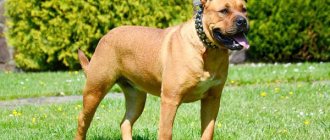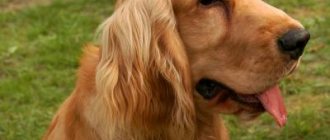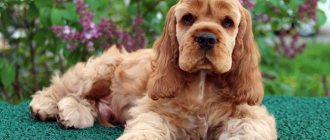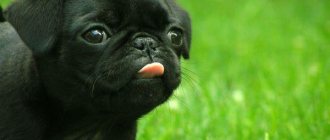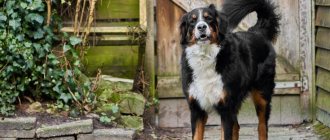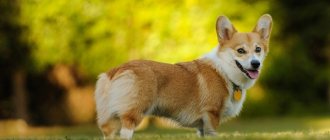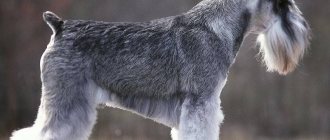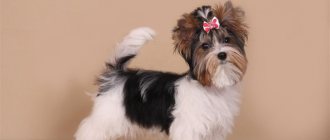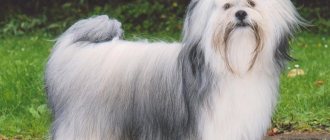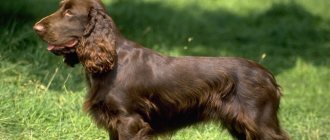Origin of the breed
In the 19th century, the favorite pastime of the Russian tsars was hunting; fabulous amounts of money were spent on the selection and maintenance of hunting dogs. Working hunting dogs were presented as expensive gifts from European monarchs to the rulers of Russian lands. With the advent of the English Cocker Spaniel in Russia, connoisseurs of elite hunting have become increasingly interested in game birds. But the short-legged, aristocratic English dog could not move with sufficient speed through the weeds and ravines of central Russia.
Interesting! The history of the breed is rooted in the creation of the English Cocker Spaniel breed, the Springer Spaniel and the desire of hunters to obtain a universal working dog for game birds.
By crossing various spaniels (mainly English and Springer), it was possible to obtain a relatively uniform dog.
Purposeful breeding work began in 1927 in St. Petersburg. In 1945, Moscow became interested in the new species, and a club for breed lovers appeared. In 1949, intensive work began on developing a new domestic breed - the Russian hunting spaniel. The official birthday of the breed is 1951, the first standard was drawn up and a stud book was opened. Since 1972, the Russian Spaniel has completely stopped mixing genetic codes of other breeds.
Interesting! The Russian Hunting Spaniel is not recognized by the International Canine Federation.
History of the origin of Russian hunting spaniels
Interestingly, this particular breed is the only Russian hunting gun dog. Officially, it appeared relatively recently - it was included in the lists of breeds only in 1951.
However, in fact, the breed is at least a century older - references can be found in hunting periodicals dating back to the mid-nineteenth century. Two English hunting breeds were used for breeding: the springer spaniel and the cocker spaniel. Of course, then hunting was the privilege of the richest people, so the breed could not be called widespread.
Already in the 30s of the last century, hunting became available to many Soviet people, so the popularity of the dog rose sharply. It was then that the first standardization measures were taken - experts began to draw up requirements for the breed. And two decades later, the dog was included in the register of the Russian Canine Federation.
For reference! The International Canine Federation never recognized the Russian spaniel as an independent breed.
Related breeds
The closest relatives of the Russian spaniel are the American and English cocker spaniels, but the difference between them is not only in color and coat type, but also in hunting instincts and constitution.
English cocker spaniel
The domestic spaniel differs from the English cocker in the shape of the skull and body. The Russian has longer legs and a more extended format. The English spaniel is more squat and stocky. Visually, the ROS looks small and light, but is not inferior in endurance and performance. The English “relatives” are not so willing to fetch game from the water, but they are not inferior in flair and thirst for hunting.
American Cocker Spaniel
The American Cocker Spaniel has a more aristocratic appearance compared to its prototypes, with clear lines of the head and back, and more abundant hair. He is inferior in height and weight, although he is just as active and hardy. Working American Cockers can be practically counted on one hand due to their aesthetic beauty. Increasingly, Americans meet at exhibitions rather than hunting.
Lifespan and reproduction
Of course, every breeder wants to know how long his beloved dog can live. The average is from 12 to 14 years. But with proper care and innate health, it may well increase by 2-4 years.
For breeding, it is better to select dogs 2 years old. You can use younger ones, even eight months old, but the puppies will most likely be born with defects, and this will not be beneficial for the parents.
It is advisable to cross a male dog no more than 2 times a year, and a female dog no more than once a year.
For reference! Such famous hunting writers as Bianchi and Prishvin were very fond of spaniels. The first had three pets, and the second had four.
Description and breed standard
A brief description of the breed is presented in the table:
| Short description | |
| Origin | Russia |
| Conditions of detention | Private house or apartment |
| Purpose | Hunting, gun, companion |
| Color | Solid, bicolor piebald, tricolor, with tan |
| Wool length | Middle length |
| Adult dog size | Height 36–44 cm, weight up to 20 kg |
| average life expectancy | 12–15 years |
| Walk | Mandatory, from 2 times a day |
| Need for physical activity | High demand - from 2 hours a day |
| Classification of the International Canine Federation (FIC) | Not recognized by the IFF |
| Puppy cost | From 5 thousand rubles to 20 thousand, depending on the pedigree and working qualities of the parents |
Description of parameters:
- General form. A compact, squat dog with a slightly stretched format. Strong, with good muscles.
- Head. Relative to the small size of the body, the transition from the forehead to the muzzle is pronounced, but not strongly, the occipital protuberance is weakly expressed. Scissor bite, full set of 42 teeth. The ears are hanging, located at eye level or slightly higher, the length of the ear reaches the nose. The eyes are symmetrically located, dark brown in color, not too prominent. The nose and rims of the eyelids are ideally black; in red colours, pigmentation to match the color of the coat is allowed. The lips are dry, fit tightly to the jaw, jowls cover the lower jaw.
- Neck. Set relatively low, with slight dewlap, strong, with well-developed muscles.
- Frame. Stretched format (stretch index - 110–120%). The chest is wide and deep, reaching to the elbow joint. The back is straight, the withers are well defined, the loin is short and muscular. The croup is quite sloping.
- Limbs. Straight, strong, parallel to each other, with good articulation angles. The hind legs are very muscular, the toes are arched. Pasterns without markings. The length of the front legs is equal to half the height at the withers.
- Tail. Located on the line of the back, held no higher than its level. In working dogs it stops after the fourth vertebra.
- Sexual dimorphism is pronounced. Its presence is encouraged, but females of the male type are not disqualified.
Congenital characteristics for disqualifying a dog:
- too large or small in height (dwarf) and weight of the stated standard;
- too aggressive;
- shorthaired or mongrel haired;
- solid white color;
- presence of malocclusion;
- mixed breeds with other spaniel groups;
- erect or short ears.
Coat and color
The guard coat of the Russian Spaniel is of medium length and coarse, lying close to the body, slightly wavy, but without curls. Longer on the stomach, ears, and paws than throughout the entire body. There is practically no undercoat. Due to the lack of undercoat and tight-fitting outer coat, the dog looks almost smooth-haired.
There are three varieties of colors:
- solid;
- two-color;
- tricolor.
Solid color can be: black, red, brown (chocolate). With all solid colors, white markings on the chest, paws, and tail are acceptable. Red can be any shade - from golden to reddish.
There are two-color ones: black and white, red and white, brown and white. Two-tone colors are also called piebald or harlequin.
Tri-color colors include solid black or brown with white markings and red tan, or piebald with black and tan markings on a white background.
Weight and height
The preferred height at the withers for males is 40 centimeters (+-2 cm), for females - 38 centimeters (+-2 cm). An adult male ideally should not weigh more than 20 kilograms, a female - more than 17.
It is important to know! Height and weight parameters are relative. The main thing is that the dog looks organic for its size and does not have excess weight. The exterior can only be fully assessed on a fully formed individual. Russian spaniels grow until they are 18 months old.
Brief description of the Russian Spaniel dog breed
- The height of an adult dog: for males from 38 to 44 centimeters, for females - from 36 to 42 centimeters.
- Weight: 15-20 kilograms.
- Characteristic color: monochrome – red, brown and black; two-color – brown-piebald, black-piebald, red-piebald; tricolor - black and brown with tan or white with strokes and spots.
- Coat Length: Long, soft, shiny and slightly wavy. On the head and front sides of the legs the hair is short, on the sides, back, croup and neck it is long and thick.
- Life expectancy: 12-15 years.
- Advantages of the breed: friendly, playful, loves children, well suited for keeping in an apartment.
- Difficulties of the breed: a hunting dog with all that it implies. Needs frequent walks, long coat.
- Average price for a Russian spaniel: from 100 to 1100 dollars, depending on the purpose and pedigree of the puppy.
Breed characteristics
The Spaniel's personality is suitable for any person. Representatives of the breed get along well in families with children and single people, with experienced or novice hunters. Not suitable only for lazy people - the spaniel is too energetic.
He has a lively, playful disposition and behaves like a puppy until old age. Ready to follow the owner with its tail, wanting to attract attention. At the same time, it lends itself well to training and has remarkable endurance. Not prone to dominance, gets along well in a pack of several dogs.
It has excellent innate hunting qualities. Easily learns to retrieve ducks from the water and search for wounded birds. You can train to follow a blood trail, follow a hare, or even use a dog for fishing. The spaniel is more obedient than the husky, but is no less comfortable and hardy in hunting. It will not be difficult even for a novice hunter to develop a ROS into a universal hunting assistant.
Despite the versatility of the spaniel, we must not forget that, first of all, it is a gun dog. Its true purpose is to lift the bird on its wing. But the breed allows you to choose who to hunt.
Host reviews
Roger2000
Advantages: active, beautiful, easy to train; excellent sense of smell, loves water, true friend, loyal, smart, good hunter
I had the opportunity to live and communicate with dogs of this breed for quite a long time. It so happened that my father is an avid hunter. And at one time he got the first Russian spaniel in our city. The dog was bred exclusively for hunting purposes and has proven itself to be 200% successful as a bird and waterfowl hunter!!! In addition, she showed herself to be a very smart dog, very kind and sociable, easy to train and able to perform many different tricks, which, when presented appropriately, greatly amused the audience.
A dog of this breed is easy to keep even in a city apartment. But what it will be like in everyday life depends only on you. To keep a pet of this breed in good shape, you need to take her for a lot of walks, be sure to take her to a pond so she can swim. Some dogs, with appropriate training, can even learn to dive. Not in the sense of swimming underwater like a fish, but plunging your head under water so that your ears float on the surface and getting, for example, a shell from the bottom - this is no problem! In my practice, our dog spent half a day “afloat”. My father often hunted in flood lands in waist-deep water. The dog accompanied him all the time and performed its functions perfectly.
Summary. The dog is versatile, smart, versatile, loyal. It will always encourage you to live actively and move a lot. But character can also be complex. It depends on your luck and who wins... But that’s just the way it is, a dog’s life.
Kasiaso
Advantages: many advantages!, loyal, too good for this world!, good hunter
Disadvantages: crawls through garbage dumps, picky eater
My Buddy has already begun to develop into a real adult dog. Today we went to the local lake, they opened the swimming season, I ran into the water after the ducks, then either with horror or with delight - I still don’t understand - I ran out of it, and immediately dried up. In general, the locals said that I have a hunter - that’s what I need! Today we learned two more commands - to lie down and next to me, in addition to those that were learned in advance - to sit and to me. I'm very happy. We like to run through garbage dumps, but as soon as I impressively tell him “Come to me,” he immediately drops everything and runs to me. At home with me all the time. No matter what guests come, he always sits with me. Even when I go to the bath, it’s a sin not to let him in with me! It'll make you laugh. And he doesn’t let me into the store. He whines and waits for me, and people leave the store and are touched that he’s still 6 months old, and already he’s so devoted! I have wanted a dog for 8 years. I dreamed that the whole apartment was still covered in toy dogs. But I love mine more!
Voodoo Doll
Such a dog lives with my close friend, from the very puppyhood it was clear that this is a dog with an awl in the nth place :) THIS IS A VERY ACTIVE DOG! And such a dog requires real training and constant exercise in the fresh air, you just need to run away until you fall off your feet, otherwise this adorable dog will destroy your entire apartment! This happened to my friend, she lived in a rented apartment with her boyfriend, the apartment is small, everyone is at work all day, and the dog is bored, she wants to go outside, and as a result, torn furniture, linoleum torn from the floor, eaten shoes. Until the age of three, this sweet, active girl was simply uncontrollable; at the sight of acquaintances (for example, me), she immediately attacked to lick her, very playful and not averse to taking an extra bite.
She sheds shamelessly and my poor friend cleaned the house every day because... there was wool everywhere! With an appetite, these dogs love to eat everything perfectly and especially love to beg for things that are not allowed to them (chewing gum or candy). I can say from myself that this dog is not for home keeping - it’s a fact! She will simply wither away in an apartment, she needs fresh air, constant space, the ability to run until she loses her pulse, this dog cannot sit locked up all day waiting for you to return from work. If she lives in such conditions, she will likely develop problems with character and behavior, and may become sad or aggressive. This is why my friend’s dog lives in the country from the beginning of spring until the end of autumn; it is very difficult for her in the city.
Anna1975
Advantages: many advantages!, loves water, loyal, smart, good hunter
Disadvantages: wayward
Our first dog lived with us for 4 years, the second one now – 10 months. When our dog died there was no question of who we would have now. This is such a gorgeous breed of dog, such a devoted friend, an incomparable treasure. Of course, the breed is active, one might say hyperactive, especially when young. This is a helicopter dog, it doesn't run, it flies. When leaving the house, we fasten it to avoid destruction of the apartment. She chooses her pet herself, but is lenient towards all family members. She plays with the child with pleasure, fools around, but when she gets tired of the game she can bite lightly. Although short-haired, she produces a lot of fur in the house, loves water, and is an excellent swimmer. A dog with character, training and education are required, at least taking into account the fact that it is a dog and it lives in an apartment.
Video
Maintenance and care
Spaniels are not suitable for keeping in a kennel; the lack of undercoat does not allow them to feel good outside all winter. The ideal housing option is a private house, but with appropriate walking, you can keep a Russian hunter even in a small apartment.
Walks
Spaniels are very active dogs with a strong hunting instinct. They can cause trouble within the city, because they love to chase pigeons and other birds not suitable for hunting. This behavior must be stopped by methodically raising the dog, showing it the boundaries of what is permitted.
For long walks outside in winter or in very bad weather, it is recommended to use special protective clothing: raincoats and overalls for dogs. It is not advisable to toilet train at home - the animal is too active, and without a long walk it can exhibit destructive behavior.
Combing and cutting
The absence of a thick undercoat allows you to do without grueling daily combing. But dead guard hair needs to be removed about once a week. During the molting period - 2-3 times in 7 days. You need to use a fine-tooth comb or a furminator.
Working dogs receive exclusively hygienic haircuts. The hair is trimmed between the paw pads and around the anus. In order for the dog not to freeze while hunting, there is no need to cut it anymore, although after running through weeds and bushes, the appearance of the coat will have to be brought back to normal.
Cleaning ears and teeth
The ears and teeth of a completely healthy dog do not cause much trouble. You can take care of your teeth using special toothpastes and brushes designed for pets. Cleaning at home should be done no more than 2 times a month. Pets with dental problems tend to develop tartar every week. It is recommended to have the mouth examined by a veterinary dentist twice a year.
A healthy spaniel's ears do not require special attention. Cleaning can be done as the ear gets dirty (1-2 times a month), but you need to constantly monitor the condition of your ears. Working dogs are prone to infection with ixodid and ear mites, which lead to inflammatory processes in the body.
Antiparasitic treatment
Treatment for ectoparasites and helminths is very important for working spaniels. The hunting season coincides with the time of active hunting of the ixodid tick and it is not difficult to become infected with worms in the wild.
Preventive treatments against helminths are carried out at least once every 3 months. If the dog is infested, the procedure must be repeated after 10–14 days. It is more expedient to treat animals living in a flock at the same time.
Prevention of ectoparasites is carried out according to the instructions of the selected method. The choice of antiparasitic drug is up to the dog owner, depending on the pet’s individual tolerance and the owner’s financial capabilities. Each product has its own pros and cons, and it is up to the owner to decide which one to use.
How to care for your fur
You need to start caring for a Russian Spaniel puppy from the first days he is in the house. The good thing is that it is not difficult to do. These dogs are not capricious and not picky in matters of haircuts, bathing and combing.
To keep the coat in good condition, it is enough to wash the dog once every 2-3 weeks. Using cosmetic oil will help prevent the formation of tangles. It is used to treat hair in the armpit and groin area.
You need to brush your dog several times a week. Soft and hard brushes are suitable for puppies. Older individuals will benefit from long-toothed combs.
A spaniel should be taken to a groomer for an exhibition haircut. If hygiene is needed, then the owner can do it himself. Removal of excess hair on the paws, around the auditory and anal openings is carried out once every 2 weeks. The hair on the back is not cut.
Breed diseases
The Russian Hunting Spaniel is a healthy breed, but there is a tendency for some diseases. Among them:
- otitis;
- obesity (prone to overeating);
- allergy;
- lacrimation.
By knowing breed predispositions, all diseases can be prevented. To do this, it is enough to monitor the quality, volume and diet, condition of the ears and eyes.
How long Russian spaniels live depends directly on their state of health. The average life expectancy is 12–15 years.
Vaccinations
Immunization of domestic animals against rabies is required by law. Vaccinations against all other viral infections are done at the discretion of the owner. But for working dogs, vaccination is a necessary procedure, since wild animals are carriers of viral diseases, including rabies.
Important! Veterinary institutions have the right to refuse admission if the dog is without a muzzle, no matter how kind it may be.
When to get the first and subsequent vaccinations, what types of viruses there are - find out from the table
| Age | Diseases | Notes |
| 6 – 10 weeks | Parvovirus enteritisLeptospirosisCarnivore plagueInfectious hepatitis | First vaccination |
| 10 – 14 weeks | Parvovirus enteritisLeptospirosisCarnivore plagueInfectious hepatitis | Revaccination |
| 10 – 14 weeks | Rabies | The first immunization, if the puppy is kept in a greenhouse, can be postponed until the change of teeth |
| 10–12 months | Parvovirus enteritisLeptospirosisCarnivore plagueInfectious hepatitis | Last puppy vaccination, repeated every year |
| 10 – 12 months | Rabies | Last puppy vaccination, repeated every year |
Adult dogs are vaccinated once a year, often using a complex vaccine against rabies and other common viruses. Before each immunization, it is necessary to carry out helminth prophylaxis.
Competent care
In addition to compliance with the conditions of detention, the Russian hunting spaniel also needs appropriate care. Brushing, bathing, cutting, walking - everything, as with all dogs.
Wool
The coat must be combed regularly (more than three times a month) using a furminator. Tangles, if any, need to be removed. The pet is given a haircut so that it is almost unnoticeable. To do this, use a machine or scissors.
Important! The tail, back of the legs and belly should not be touched.
It is not recommended to cut the hair in the neck, chest and ears. That is, the haircut must be hygienic. It is imperative to remove the hair on the paws and between the toes.
Bathing
Bathe your pet twice or thrice a month. Use a special zoo shampoo or product for dry hair. After the procedure, the wool must be lubricated with cosmetic oil to avoid tangles.
Did you know? The fastest dog breed is the Greyhound. Maximum speed is 70 km/h.
Also, for easy combing and protection of parasites, you can rinse the fur with a light solution of acid (citric, acetic).
Screening for infections
It is very important to periodically examine your dogs ears and eyes. Eyes often water, and ears are very prone to infections, so they need regular cleaning, just like teeth. As for the claws, there is no need to trim them if the pet spends most of its time outside.
Daily walks
Regardless of the conditions in which the spaniel lives, walks are simply necessary for the dog. Keep him in good shape through exercise, especially if you plan to go hunting together. Walk your pet as often as possible, play with it, train it.
Important! You can let the puppy run on the ground only after the first vaccination.
Walk your spaniel twice a day. Walking duration is up to three hours. It is better to choose a place away from the road (lawn or forest). Only a dog that listens to you and knows commands can be let off a leash near people.
Nutrition for puppies and adult dogs
Regardless of the owner’s decision on what to feed his dog, natural or dry food, it is necessary to follow the feeding regime. Adults, whatever the breed, need to be fed no more than 2 times a day.
It is difficult to choose a complete diet, rich in all the substances necessary for health, on your own. Therefore, many owners increasingly prefer industrial ready-made food.
Puppies' diet by month:
- Newborns - 1 month. The mother of the puppies monitors the feeding regime.
- 2 months. The breeder begins to feed the babies 2-4 times a day, depending on the number of puppies and the bitch’s ability to feed them.
- 3–4 months. Puppies are fed small portions every 3 hours, 6 times a day.
- 4–6 months. The interval between feedings and portion size are increased, food is given 4 times a day.
- 6–10 months. Teenagers are served breakfast, lunch and dinner.
- 10–12 months. You can gradually approach the regime of an adult dog - 2 times a day.
What to feed a Russian spaniel
Spaniels need to eat properly , they tend to overeat, so you need to watch this. It is imperative to give your dog vitamins. You can feed him dry food or natural food.
Puppies should be fed the same way they were fed by the breeder. Over time, you can create your own diet.
adult dogs twice a day; small puppies should be fed little, but often, 5-6 times a day. As you get older, reduce the number of meals you eat.
How to choose a puppy
Before you go for a puppy, you need to study its pedigree and talk with the breeder about the working instincts of the parents. Breeders and nursery owners are willing to make contact with the future owners of their charges. If you travel far, you can ask to send a photo or video of both parents and the babies themselves to assess their condition. An obvious breed defect is noticeable even in photographs.
You should not buy puppies from dogs whose breed is in doubt, or if they are kept in poor conditions (on a chain, in a kennel on the street). It is impossible to predict how developed the hunting instinct is in such individuals. Parents who are kept in terrible conditions often have a huge number of genetic and acquired diseases. Caring for a puppy from such breeders can be expensive, troublesome, and ultimately futile.
Nicknames for Russian Spaniel
The choice of a nickname for a working dog should be primarily aimed not at aesthetics, but at how the dog will remember it and respond to it. The nickname should be clear, short, and sonorous. You should avoid words that are difficult to pronounce or too long - it may be difficult to call when hunting.
For boys
Suitable names for spaniel boys:
- Robie;
- Roy;
- Rudy;
- Barney;
- Raf;
- Oscar;
- Roni;
- Kai;
- Kevin;
- Radar;
- Noah;
- Ren;
- Eric;
- Hoshi.
For girls
Suitable nicknames for girls spaniels:
- Molly;
- Dolly;
- Lucky;
- Laura;
- Dory;
- Nika;
- Mary;
- Boni;
- Lika;
- Sparta;
- Bullet;
- Puma;
- Us;
- Whiskey.
Coat
The Russian hunting spaniel has an unusual coat. Dog breeds that are used for hunting most often have short and coarse hair, which protects the animal's skin from damage. In a spaniel, it is moderately long, straight or slightly wavy, shiny, and tight-fitting. On the front of the legs and on the head, the hair is straight and short. On the back, upper side of the neck, croup and sides – moderately thick and long. The underside of the chest, neck, abdomen, the inner side of the hind and forelimbs, the lower part of the tail is covered with hair. It is softer, longer, slightly wavy, creating feathering and dewlap.
Education and training
Russian spaniels are diligent students, especially when it comes to learning how to hunt game. The innate desire to search for and raise a bird is so strong that special training is often not needed. With systematic training to find and retrieve birds, the spaniel will become a universal hunter.
How to train, how many commands to study - this must be decided by the owner from the moment the puppy arrives at home. You can train a spaniel in basic obedience at home, without the help of specialists.
It is important to know! The main thing is to be consistent, methodical, calm. Before starting training, you need to decide: what a dog needs to know in order to become comfortable and useful for the owner.
Reviews of the Russian Spaniel
Maria is a very kind and obedient dog, she loves children very much. We bought it and now we can’t be happier. How happy our son is!
Alexander It took a long time to choose a dog. In the end, we chose a Russian spaniel. At first we were afraid that he needed space, but he is not at all sad in our apartment. Smart, kind and affectionate! We are very pleased!
The Russian Spaniel is such an unusual breed that combines the characteristics of an excellent hunting dog and a pet. What is the best way to train a dog so that these skills are perfectly combined and harmonized? Share your experience with us in the comments!
Share
Leave a review
Estrus, mating and pregnancy
Owners of females not intended for breeding are recommended to undergo complete castration before the first heat. This will save you from many problems during collective hunting and hormonal imbalances in the body. Owners of bitches with breeding value need to understand that during estrus and pregnancy the dog will fall out of heat.
Estrus occurs during puberty - from 6 to 11 months, depending on the characteristics of the body. Mating is allowed to be planned no earlier than the third heat or upon reaching the age of 18 months. The male is looked for in advance, and the female is taken to the male’s territory for mating on the 10th–15th day of estrus. A veterinarian can predict a good day for mating after examining a female dog in heat. Females remain pregnant for 56–64 days.
Hunting with a Russian Spaniel
With the Russian Hunting Spaniel, hunting turns into an exciting sporting competition. This is the best gun dog - it does not leave the hunter, flawlessly carries out commands, and does not drive the game too far.
With a Russian Spaniel you can go hunting for any type of game birds or small furs. This breed is excellent for searching for wounded animals or holes, following a blood trail. ROS can not only lift a bird under a shot, but also bring it back to the hunter. It is noteworthy: spaniels get excited very quickly, and in this state they are ready to work in any weather conditions.
Interesting! At the end of the twentieth century, Russian spaniels were used to hunt even small ungulates.
Hunter reviews
Real reviews from owners:
- A very beautiful, kind and active dog. Even if you don’t go hunting with her, she forces you to walk a lot, and this is good for your health. Her husband always takes her with him, even on fishing trips, and never returns empty-handed.
- Excellent working qualities. Although the puppy was not taken from hunters, on his first trip to pick mushrooms, the little puppy “obtained” a mouse den - he smelled it and dug it up! After some training, we went with him to duck - he picks him up and pulls him out even from impassable reeds. I advise all bird hunters to get a Russian spaniel.
The best ingredients for a productive hunt are a Russian spaniel, a gun and a hunter.
Character
The Russian Spaniel is not only an excellent hunting dog, but also a loyal, loving pet. Dogs of this breed are quite small and adapt well to life in a small apartment. However, they are very active outdoors.
Charming and friendly, Russian Spaniels will happily greet guests, but remember that they have excellent intuition and are able to recognize suspicious people.
In general, Russian Spaniels are easy to train, attentive, athletic and friendly dogs.
The Russian hunting spaniel has all the necessary qualities of a gun dog: endurance, excellent scent, energy, tenacity and an innate desire to bring prey. These dogs start working early and do not require much training. During a hunt, a Russian spaniel looks for a bird, lifts it on its wing and, after shooting, brings it to the hunter on command.
This dog is not well suited for hunting in prey-poor areas, very dense brush, or in extremely difficult conditions. Russian Spaniels are small dogs and can become exhausted. But in places rich in spoils, they are very inspired and energetic. Hunters often use the abilities of Russian spaniels to hunt quail, jerk, sandpiper, hare and wild goat.
Pleasant appearance and a cheerful, cheerful disposition have made dogs of this breed excellent companions who never lose sight of their owner. These dogs also get along well with children and will always warn of danger.
